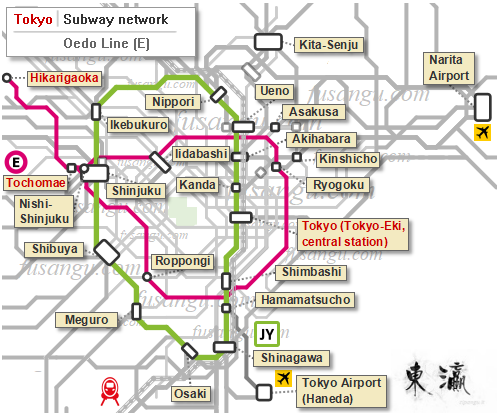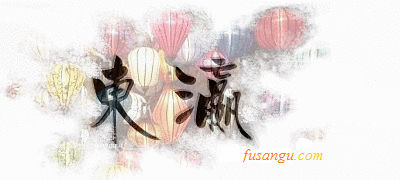
The Oedo-sen is one of the four subway lines managed by Toei, Tokyo’s municipal transportation company.
The long line describes a path in the shape of the number 6. In the centre the line connects some of Tokyo's most popular tourist areas such as Shinjuku, Bunkyo, Ueno, Sumida, Chuo, Minato just to name a few.
In this page we describe a one-day tour along the Oedo Line. The article includes programmes that are suitable for those who are in Tokyo for periods longer than 3-4 days.
If you visit Tokyo for the first time and plan to stay in the city for a short period (3-4 days), you will most likely get around only by making use of the Asakusa, Ginza, Hanzomon, Marunouchi and Fukutoshin subway lines.
Another option, particularly convenient if you travel with a JR Pass, is to use the Yamanote-sen (the loop line) and Chuo-Sobu railway lines.
The above mentioned lines serve all major sightseeing places and tourist areas where you are likely to spend the first week in Tokyo.
If you like venturing out of the typical visiting paths or if you wish to visit less touristy areas, you may find useful to get around with the Oedo Line.
Though technically a circular line like the Yamanote Line, the Oedo Line describes a loop around the centre of Tokyo. Differently from the Yamanote Line, the Oedo Line does link fewer major tourist destinations but is of greater usefulness to those who wish to visit less known neighbourhoods and minor destinations. The line is particularly useful to those who choose to lodge in Shinjuku or Sumida.
Recommended itinerary along the Oedo Line
Below we give brief descriptions of two interesting itineraries along the Oedo Line. The first one is very suitable to those who visit Tokyo for the first time.
From Shinjuku to Sumida through Bunkyo and Asakusa
Below is a programme with starting point in Shinjuku, core of the modern city and major centre of Tokyo’s night life.
Choosing a different sequence of visits poses no difficulty. The programme is very suitable also for those who wish to find accommodation in Asakusa or Sumida, a quiet area full of hostels and cheap hotels.
As a few rides are needed, we suggest you buy a day pass.
The tour starts from Shinjuku-Nishiguchi Station (E01). This is a satellite station located in the area of the main hub of the district, Shinjuku Station.
Programme:
-
8:30 - 10:00: transfer by subway along the Oedo Line between Shinjuku-Nishiguchi Station and Iidabashi Station. You can then reach on foot Koishikawa Koraku-En, one of Tokyo’s main traditional gardens. After the visit (which should last at least half an hour) you can return to Iidabashi Station. In spring you can go past the station until you reach Sotobori Park. This is a pleasant park full of cherry trees;
-
10:00 - 12:00: transfer to Hongo-Sanchome Station. From the station you can walk to Yushima Seido, a confucian temple. This is the first destination to be visited in Kanda, a traditional district rich in cultural heritage and prestigious universities. The next destination can be Kanda Shrine, one of the most popular Shinto shrines of Tokyo. Not far is Origami Kaikan, a small museum devoted to the art of origami;
-
12:00 - 12:30: lunch break;
-
12:30 - 14:00: transfer to Kuramae Station. A 15-minute walk takes you to Senso-Ji, a historic temple and cultural heart of Asakusa, a neighbourhood of the former Shitamachi. The temple is at the centre of a lively area full of souvenir shops, small boutiques and cheap eateries;
-
14:00 - 14:30: a pleasant walk from Asakusa to Ryogoku allows you to go through Sumida Park. This is another major cherry blossom spot;
-
14:30 - 17:30: visit to the Museum of the Japanese Sword or Yokoamicho Memorial Park. History buffs may consider a visit to Edo-Tokyo Museum. Alternatively, if you are interested in Japanese art, you may opt for Sumida Hokusai Museum.
Related articles:
Main article: Tokyo 3-day itinerary
Itineraries along the subway lines (Asakusa, Hibiya, Ginza, Marunouchi, Tozai, Mita, Namboku, Yurakucho, Chiyoda, Shinjuku, Hanzomon, Oedo, Fukutoshin)

